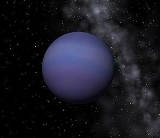
Gliese 86 b
Encyclopedia
Gliese 86 b, sometimes referred to as Gliese 86 Ab (so as to distinguish the planet from companion star "B") and or shortened to Gl 86 b, is an extrasolar planet
approximately 36 light-year
s away in the constellation
of Eridanus
. The planet was discovered orbiting a K-type dwarf star
(Gliese 86
) by French
scientists in November 1998. The planet orbits very close to the star, completing an orbit in 15.77 day
s.
The preliminary astrometric
measurements made with the Hipparcos
space probe suggest the planet has an orbital inclination
of 164.0° and a mass 15 times Jupiter, which would make the object a brown dwarf
. However, further analysis suggests the Hipparcos measurements are not precise enough to reliably determine astrometric orbits of substellar companions, thus the orbital inclination and true mass
of the candidate planet remain unknown.
The radial velocity measurements of Gliese 86 show a linear trend once the motion due to this planet are taken out. This may be associated with the orbital motion of the white dwarf companion star.
Extrasolar planet
An extrasolar planet, or exoplanet, is a planet outside the Solar System. A total of such planets have been identified as of . It is now known that a substantial fraction of stars have planets, including perhaps half of all Sun-like stars...
approximately 36 light-year
Light-year
A light-year, also light year or lightyear is a unit of length, equal to just under 10 trillion kilometres...
s away in the constellation
Constellation
In modern astronomy, a constellation is an internationally defined area of the celestial sphere. These areas are grouped around asterisms, patterns formed by prominent stars within apparent proximity to one another on Earth's night sky....
of Eridanus
Eridanus (constellation)
Eridanus is a constellation. It is represented as a river; its name is the Ancient Greek name for the Po River. It was one of the 48 constellations listed by the 2nd century astronomer Ptolemy, and it remains one of the 88 modern constellations. It is the sixth largest of the modern...
. The planet was discovered orbiting a K-type dwarf star
Star
A star is a massive, luminous sphere of plasma held together by gravity. At the end of its lifetime, a star can also contain a proportion of degenerate matter. The nearest star to Earth is the Sun, which is the source of most of the energy on Earth...
(Gliese 86
Gliese 86
Gliese 86 is a K-type dwarf star approximately 35 light-years away in the constellation of Eridanus. It has been confirmed that a white dwarf orbits the primary star...
) by French
France
The French Republic , The French Republic , The French Republic , (commonly known as France , is a unitary semi-presidential republic in Western Europe with several overseas territories and islands located on other continents and in the Indian, Pacific, and Atlantic oceans. Metropolitan France...
scientists in November 1998. The planet orbits very close to the star, completing an orbit in 15.77 day
Day
A day is a unit of time, commonly defined as an interval equal to 24 hours. It also can mean that portion of the full day during which a location is illuminated by the light of the sun...
s.
The preliminary astrometric
Astrometry
Astrometry is the branch of astronomy that involves precise measurements of the positions and movements of stars and other celestial bodies. The information obtained by astrometric measurements provides information on the kinematics and physical origin of our Solar System and our Galaxy, the Milky...
measurements made with the Hipparcos
Hipparcos
Hipparcos was a scientific mission of the European Space Agency , launched in 1989 and operated between 1989 and 1993. It was the first space experiment devoted to precision astrometry, the accurate measurement of the positions of celestial objects on the sky...
space probe suggest the planet has an orbital inclination
Inclination
Inclination in general is the angle between a reference plane and another plane or axis of direction.-Orbits:The inclination is one of the six orbital parameters describing the shape and orientation of a celestial orbit...
of 164.0° and a mass 15 times Jupiter, which would make the object a brown dwarf
Brown dwarf
Brown dwarfs are sub-stellar objects which are too low in mass to sustain hydrogen-1 fusion reactions in their cores, which is characteristic of stars on the main sequence. Brown dwarfs have fully convective surfaces and interiors, with no chemical differentiation by depth...
. However, further analysis suggests the Hipparcos measurements are not precise enough to reliably determine astrometric orbits of substellar companions, thus the orbital inclination and true mass
True mass
The term true mass is synonymous with the term mass, but is used in astronomy to differentiate the measured mass of a planet from the lower limit of mass usually obtained from radial velocity techniques...
of the candidate planet remain unknown.
The radial velocity measurements of Gliese 86 show a linear trend once the motion due to this planet are taken out. This may be associated with the orbital motion of the white dwarf companion star.

